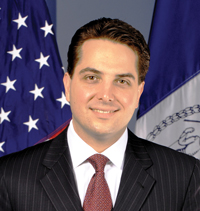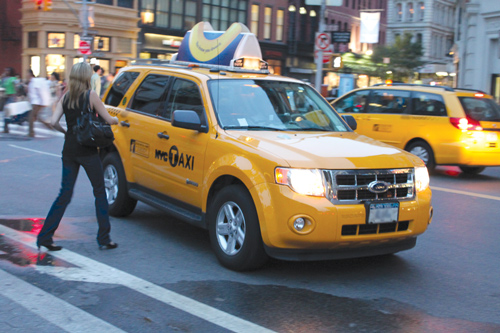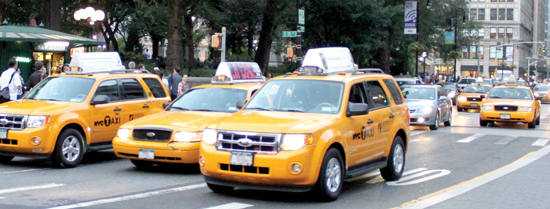 IN FOCUS IN FOCUS |
by Matthew W. Daus, Esq.
President, International Association of Transportation Regulators • Distinguished Lecturer, University Transportation Research Center, Region 2
Contact: mdaus@windelsmarx.com • 156 West 56th Street, New York, NY 10019
T. 212.237.1106 • F. 212.262.1215
|
 |
STREET HAIL LIVERY LITIGATION – LEGAL ANALYSIS & NEXT STEPS
In December 2011, Governor Andrew M. Cuomo signed a Chapter Amendment authorizing New York City (the “City”) to allow for street hail service in northern Manhattan and the four City outer boroughs.[1] In February 2012 revisions were made to the Chapter Amendment, and the final Street Hail Livery Law was enacted which provided for the City to issue up to 18,000 Street Hail Livery vehicle licenses and 450 Street Hail Livery base permits for the for-hire base stations.
The law requires that twenty percent (20%) of all Street Hail Livery vehicles be wheelchair accessible. Additionally, the law authorizes the NYC Taxi & Limousine Commission (“TLC”) to auction 2,000 medallions for accessible yellow taxicabs which vehicles are permitted to pick up street hails in all boroughs, including the central business district in Manhattan.[2]
Earlier this year, several industry lenders, trade organizations and an elected official commenced a lawsuit against the City of New York challenging the new Street Hail Livery Law.[3] On June 1, 2012, Justice Engoron issued a temporary restraining order (“TRO”) preventing the TLC from moving forward with implementing the Street Hail Livery Law. The court based its decision on a finding that the statute violated the home rule clause of the New York State Constitution.
On August 17, 2012, as I previously predicted would happen, Justice Engoron issued his decision in which he found the Street Hail Livery Law violated the New York Constitution Article IX, Section 2(b)(2) (the ”Home Rule Clause”). In addition to the home rule provision, Justice Engoron separately found that the Street Hail Livery Law violated the New York State Constitution Article IX, Section 2(b)(1) (the “Double Enactment Clause”), and Article III, Section 17 (the “Exclusive Privileges Clause”), and that pursuant to the “poison pill” provision in Section 6 of the legislation, the entire act is null and void. What that means is that the entire Outer Borough Street Hail Plan is on hold, as well as the planned sale of 2,000 yellow taxicab medallions and various incentives for the purchase of wheelchair accessible vehicles.
Judge Engoron granted summary judgment in favor of three of the industry’s claims
(i) the home rule claim,
(ii) the double enactment claim,[4] and
(iii) the exclusive privileges claim.[5]
The court dismissed the remaining claims, namely:
(i) the improper delegation claim,[6]
(ii) the takings claim,[7] and
(iii) the environmental review claim.[8]
Given space limitations, this article will focus on providing an explanation and in depth understanding of the key “home rule” claim instead of analyzing every aspect of this voluminous decision.

The “Home Rule” Law Was the Turning Point in the Case
The decision focused primarily on the home rule claim. Plaintiffs claimed that the Street Hail Livery Law is a “special law” in that it applies in its terms, and effect, to only one city and thus required a home rule message from the City Council in order to pass constitutional muster. The exception to this rule exists where the State has a substantial State interest in the matter for which it is legislating.
As Justice Engoron made clear, this exception to the home rule requirement is alive and well and requires that the statute in question “’serve a supervening State concern’ and ‘relate to life, health, and the quality of life [of the People of the State].’”9 Moreover, this substantial State concern cannot be derived “purely from speculative assertions on possible State wide implications of the subject matter having no support in the language, structure or legislative history of the statute.”[10] The standard applied by the Court was whether there was a “substantial State concern” and second, whether there is a “reasonable relationship” between the concern and the Street Hail Livery Law.
1. “Substantial State Concern”
a. Deference to the Legislative Findings
A central focus of both the plaintiffs and defendants arguments concerning the home rule claim dealt with the level of deference that the court should accord to the legislative history of the Street Hail Livery Law. The court noted that conspicuously absent from the “Legislative findings” is mention of a substantial State interest in the power shifting aspect of the legislation involving the designation of the State Department of Transportation to oversee implementation so that “...rather than a redrawn taxicab industry we have a redrawn political map.”
b. History of Local versus State Regulation of the Taxicab Industry
The court went on to discuss the parties’ disagreement as to how the history of taxicab regulation should play into the home rule analysis. Justice Engoron drew upon the long history of taxicab regulation by the City of New York dating back to 1937,[11] and in light of 75 years of pre-emptive legislation, he noted that if “anything is conclusive in this litigation, this fact should be.”
c. History of the Street Hail Law
The court also analyzed the history of the Street Hail Livery Law from the inception of the legislation to its becoming law determining that once negotiations broke down and it was clear that the City Council would not legislate to alter the taxicab industry, the bill’s proponents went to the State in an effort to bypass the home rule message requirement. In this way, it seemed to the court that the “’legislative findings’ appear to be the ‘tail that wags the dog.’”[12]
As such, the court noted that it was unlikely that State legislators spontaneously determined that a substantial State need existed with respect to the taxicab industry located solely within the bounds of New York City for which it would be necessary to address via State legislation.
d. Inherent State Interests
Where the State has a strong, inherent interest in a particular subject matter, for instance housing, public welfare, or education, courts have rejected home rule challenges. The court here rejected the City’s argument comparing the for-hire vehicle industry to mass transportation industries, such as railways, which frequently facilitate transportation of individuals to points outside of New York City.
The court found that whereas railways are traditionally a State concern (and indeed owned and operated by the State), taxicabs are a local concern privately owned and operated and therefore not an inherent State concern.
e. Wheelchair-Accessibility Concerns
The court similarly found that the State’s interest in securing greater wheelchair-accessibility for the New York City taxicab industry provided little in the way of support for circumventing the home rule requirement. Instead, the City Council itself has been a proponent of increasing wheelchair-accessibility for taxicabs, first in 2003 and again in 2006 by raising the percentage of required wheelchair accessible taxicabs and mandating that all new medallions issued in 2006 be wheelchair-accessible. In this regard, because the issue was being addressed on a City level, the court considered the wheelchair-accessibility provision little more than “window dressing.”
2. “Reasonable Relationship”
The second prong of the home rule analysis requires determining whether the special law at issue bears a reasonable relationship to the legitimate, accompanying substantial State concern.[13] Put another way, the State concern must be directly and substantially involved. Here, Justice Engoron found that correlation lacking comparing the legislation to cracking an egg with a sledgehammer: “[h]ere, the intrusion (reallocating the powers of City government) is a mountain; the States’ asserted interest (regulating City taxicab service) is a molehill.”[14]
Instead of establishing uniform percentages for wheelchair-accessible for-hire vehicles which all cities in New York State would be required to meet, the law targets only New York City and does so by reallocating a power traditionally held by the City Council for the past 75 years to the executive branch.
What Happens Next?
Now that a final judgment has been issued nullifying the Street Hail Livery Law, the TLC has made it clear it will seek to appeal the judgment which would be filed with the Appellate Division of the Supreme Court, First Department.
The First Department would review Justice Engoron’s grant of summary judgment de novo which means “anew.” On review, the appellate court applies the same legal standard to determine if the evidence before Justice Engoron presented a factual dispute or whether the facts are one sided in favor of one party as a matter of law.
Unlike other appeals where a lower court judge’s decision is analyzed to determine whether there was an “abuse of discretion” or whether it was “clearly erroneous,” the City now may get a fresh bite at the apple. However, it will still be an uphill battle on the “home rule” issue given existing case law and Judge Engoron’s well reasoned and persuasive decision. The appeal is likely to take many months to be decided, and further appeals could follow thereafter.
On the political front, however, both the New York City Council Speaker and the Mayor have made it clear that their budgetary assumptions include over $600 million in revenue from a medallion sale. Absent threatened layoffs, increased tax collections or a “Plan B,” it is very possible we may see a new bill introduced in the State Legislature this year (or early next) to provide for a yellow taxicab medallion sale. Whether such medallions will be all wheelchair accessible is an open question though the political pressure of doing so will be heavy.
Also, it is possible that the New York State Assembly, even if politically compromised due to recent scandals, may insist on some outer borough medallion or street hail plan putting us back to square one again – both legally and politically.
In typical Albany fashion, I suspect the medallion bill will be introduced at some point, passed with a significant number of accessible medallions, and that some type of task force will be announced to work on a plan moving forward whether that actually happens or not. It is still too early to tell, so let’s watch and wait.

Windels Marx Special Counsel and former TLC Chief Judge, Pasqualino Russo, as well as Associate Julianne E. Befeler, of the Transportation Practice Group, contributed to this article.[15]
1. Senate Bill S5825 available at http://open.nysenate.gov/legislation/bill/S5825-2011; signed as Assembly Bill A8496.
2. Assembly Bill A8691A-2011 available at http://open.nysenate.gov/legislation/bill/A8691A-2011.
3. The Plaintiffs in the Metropolitan Taxicab Board of Trade (the “MTBOT”) case are medallion owners and Lewis Fidler, a member of the New York City Council. The Plaintiffs in the Taxicab Service Association (the “TSA”) case are credit unions and other entities that finance the purchase of medallions. The Plaintiffs in the Greater New York Taxi Association (the “GNYTA”) case are medallion owners and one individual. The Plaintiffs sought, and won, a temporary restraining order and a preliminary injunction precluding the implementation of the Street Hail Livery Law, and then moved for summary judgment. The Defendants in the three cases are the State of New York, Governor Cuomo, the City of New York, Mayor Michael R. Bloomberg, the TLC, and TLC Chair David Yassky. The MTBOT only brought a law suit against Mayor Bloomberg and TLC Chair Yassky, and did not sue New York State or any state officials. The Defendants moved for summary judgment on the merits.
4. Plaintiffs argued that the Street Hail Livery Law was not supported by a substantial State interest and as such, its attempt to immediately repeal, diminish, and impair the City’s power under the Statue of Local Governments, without a “double enactment” and approval by the State Legislature in the following calendar year, violated the New York Constitution, art. IX, § 2. See Decision, 27. The Court agreed.
5. Judge Engoron found that the Street Hail Livery law violated New York Constitution, art. III, § 17 which prohibits the legislature from passing “a private or local bill...granting to any private corporation, association or individual any exclusive privilege...or franchise whatsoever”, because, inter alia, under the law, the HAIL licenses and wheelchair-accessibility grants were unavailable to taxicab medallion owners. Further, even if the HAIL licenses may have been transferred to anyone with a livery license after the initial sale/purchase, it creates a windfall, at taxpayers’ expense, to a particular group. See Decision, 27.
6. Plaintiffs claimed that the Street Hail Livery Law allowed certain law enforcement agencies to collect “bounties” without any budgetary oversight and therefore, violated art. III of the New York Constitution, as an improper delegation of power. See Decision, 29. The Court found that this was not improper because it did not give the agencies the right to make “basic policy decisions”. See Decision, 28-9 (citing Bourquin v. Cuomo, 85 N.Y.2d 781, 785 (1995)). 7 Plaintiffs argued that the Street Hail Livery law violated the takings clause of the Fifth Amendment to the U.S. Constitution and art. I, Section
7. of the New York Constitution which prohibits the taking of private property for public use without just compensation, because the new medallions and HAIL licenses would so diminish the value of current medallions as to constitute a taking. See Decision, 29. The Court found this argument failed both procedurally (because there was no deprivation of economically viable uses of medallions to constitute a “facial” taking) and substantively (because the State is not destroying the value of medallions and therefore, is less than what courts find actionable). See Decision, 29-31.
8. Judge Engoron found that the State had the authority to exempt the issuance of HAIL licenses from the State and City Environmental Quality Review Acts and that the TLC’s review of the environmental impacts of the legislation was adequate. See Decision, 31-2.
9. Decision, 14 (quoting City of New York v. Patrolmen’s Benevolent Assn., 89 N.Y.2d 380, 391 (1996).
10. Id.
11. Although the State considered legislation in 1936 which would have resulted in placing the entire statewide taxicab industry under a State agency, the Legislature never acted on the bill. Rather, beginning in 1937, when the City Council enacted legislation to curb excessive competition in the taxicab industry, and continuing in the same vein until 2011, the City of New York has repeatedly and exclusively regulated the taxicab industry with respect to authorizing the issuance of medallions. As Justice Engoron noted in his opinion, “[i]nterestingly, the [Street Hail Livery Law] appears to be the first instance in which the State Legislature passed a law without a home rule message after having passed laws on the very same subject with a home rule message.” Decision, 19.
12. Decision, 20.
13. Decision, 23 (quoting City of New York v. Patrolmen’s Benevolent Assn., 89 N.Y.2d 380, 390 (1996)).
14. Decision, 24.
 IN FOCUS
IN FOCUS

